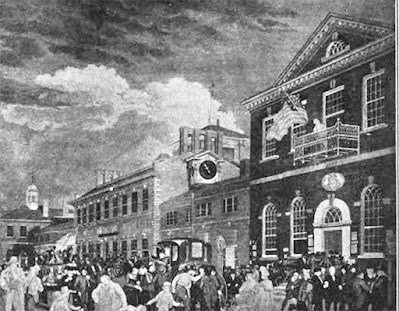American Stars #6
Wheel of Destiny by Becky Brown
The Peale Family, about 1772
Three generations by Charles Willson Peale
New York Historical Society
See a key below to the Peales in this portrait.
A fussy-cut stripe.
#6 Wheel of Destiny by Jeanne Arnieri
England sent criminals to populate Australia and North America
1822 Self Portrait in his Philadelphia gallery
(detail) by Charles Willson Peale (1741-1827)
Philadelphia Museum of Art
Her eldest Charles became quite successful as a painter, naturalist, entrepreneur and pater familius. With two wives he had 17 children, several of whom became artists, entrepreneurs and naturalists themselves. Charles counted on hereditary artistic talent and a rich environment in raising his children to be exceptional. He also aimed them high by naming them after famous artists.
The Staircase Group
Philadelphia Museum of Art
In 1795 Charles assembled this 7-foot painting/sculpture showing Titian and
Raphaelle holding a palette.
1801 Portrait of Rubens Peale ( 1784-1865) by
Brother Rembrandt Peale (1778-1860)
National Gallery of Art
(I believe if I could have one famous painting
hanging in my hall it would be this one--- well maybe the Staircase Group too.)
Titian Ramsey Peale ( 1799-1885) by His Father
Titian used his artistic talent as a scientific illustrator on expeditions to Florida, the Rocky Mountains, Colombia and the South Seas
Sandhill cranes in the Great Plains, painted during
Stephen H. Long’s 1819-20 Rocky Mountain expedition
Painting miniatures and portraits could give one a measure of fame but the Peales' main celebrity came in the area of public entertainment. They were innovators in the idea of museums.
Peale's Philadelphia Museum originated in the building we
call Independence Hall in 1784.
Library Company of Philadelphia
In 1845 the name was changed to New York Museum of Natural History and Science (unrelated to today's American Museum of Natural History.)
The building created for Baltimore's Peale's Museum still stands.
Rembrandt Peale opened Peale's Baltimore Museum and Gallery of Fine Arts in 1814. The Mastodon painting includes a Peale Family Portrait in center right.
Charles on the left. See a key to the 1806 portrait below.
In the rear under the parasol is daughter Sophonisba Peale talking with her
husband Coleman Sellers.
Sophonisba Angusciola Peale Sellers (1786–1859)
Detail of a Miniature on Ivory by her father Charles Willson Peale.
Before photography, miniature portraits were a popular
way of preserving a likeness. Many Peale men and women
made a living painting miniatures.
Self-portrait of the first Sophonisba Angusciola (1532-1665)
Philadelphia Museum of Art
Quilt attributed to Sophonisba A. Peale Sellers
Gift of Mrs. Horace Wells Sellers, 1935
The donor Cora Wells Sellars (1869-1960) was married to Sophonisba's grandson Horace Sellars,
Philadelphia architect and engineer.
Horace's obituary recalls his grandfather's family but
not the Peales.
The donor thought the quilt might date to the 1850s
but the fabrics and medallion format indicate an
earlier date of 1825-1840.
Sophonisba's quilt has been inspirational.
Sophonisba's Star by Carol Gilham Jones
Sheryl A. Low
Small version made for an American Quilt Study Group
study project.
The Block
The frame is necessary to fit the block full of
diagonals on an 8-1/2" x 11" sheet.
Later Generations
1839 advertisement
Sophonisba married engineer Coleman Sellers (1781-1834) in 1805 and gave birth to six children. Coleman owned a Philadelphia factory that built locomotives and fire engines.
Kinematoscope Gallery
Another family branch winds up in odd places. Raphaelle and Martha McGlather Peale had a son named Rueben (1808-1891) who used his artistic talent to make a living as a "coach painter" according to the 1860 Philadelphia census just before the Civil War. At 56 he enlisted in the 91st Philadelphia Infantry. Two years later he was discharged with a disability at the end of the war.
Reuben II was one Peale who looked west of Philadelphia. After the war he lived in Wauwautosa, Wisconsin, North Platte, Nebraska and lastly in Laramie, Wyoming. While in North Platte and Laramie he was employed by the Union Pacific railroad to paint railroad cars which were quite decorative at the time.
Reproduction mid-19th-c railroad car with painted decoration.
One of his children with wife Julia was Edmund (1842-1901) whose son Ohio-born Charles Clifford Peale (1870-1955) became a minister. This Charles Peale had a son born in Ohio near the end of the century who also became a minister.
Norman Vincent Peale (1898-1993)
This Peale descendant made a fortune from his best-selling book
The Power of Positive Thinking, a religious/psychology blend,
and from his periodical Guideposts.
Key to Charles Willson Peale's 1772 Family Portrait
1 Brother St George Peale
2 Artist Charles Willson Peale
3 Brother James Peale
4 Sister Margaret Jane Peale Ramsey
5 Daughter Margaret Van Bordley Peale
6 Wife Rachel Brewer Peale
7 Family Nurse Margaret Durgan
8 Daughter Eleanor born 1772
9 Sister Elizabeth Digby Peale Polk
10 Mother Margaret Triggs Peale
11 Argus
5 Daughter Margaret Van Bordley Peale
6 Wife Rachel Brewer Peale
7 Family Nurse Margaret Durgan
8 Daughter Eleanor born 1772
9 Sister Elizabeth Digby Peale Polk
10 Mother Margaret Triggs Peale
11 Argus
Key to Charles Willson Peale's 1806 Family Portrait
2 Wife Hannah Moore Peale
3 Daughter-in-law Harriet Cany Peale wife of Rembrandt
4 Son Rembrandt Peale
5 Daughter Sophonisba Peale Sellers
6 Son-in-law Coleman Sellers
7 Daughter Sybilla Miriam Peale
8 Son Rubens Peale
9 Daughter Elizabeth DePeyster Peale
10 Daughter-in-law Martha McGlather Peale wife of Raphaelle
11 Son Raphaelle Peale




































2 comments:
Thank you for this wonderful history of a fascinating family.
And such a beautiful quilt, very talented. Who knows what else she may have made.
Post a Comment